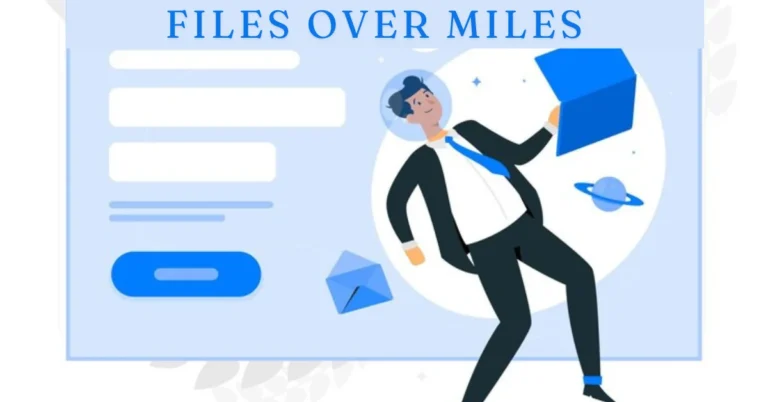In today’s digital age, the way we share files over miles over miles has come a long way. From the days of floppy disks and CDs to the era of cloud storage and blockchain, file sharing has evolved significantly. But why is efficient file sharing so crucial? Whether for business or personal use, sharing files quickly and securely is essential for productivity and collaboration.
History of File Sharing
Early Methods: Floppy Disks and CDs
Remember the good old days of floppy disks? These small, portable storage devices were once the pinnacle of technology, allowing users to transfer files from one computer to another. As technology advanced, CDs became the next big thing, offering more storage space and durability.
The Rise of Peer-to-Peer (P2P) Networks
The early 2000s saw a surge in peer-to-peer (P2P) networks like Napster and LimeWire. These platforms allowed users to share music, videos, and other files directly with one another, bypassing traditional storage media. While revolutionary, P2P networks also faced significant legal challenges due to copyright infringement.
Cloud Storage Revolution
The introduction of cloud storage services like Dropbox, Google Drive, and OneDrive marked a new era in file sharing. These platforms offered users the ability to store and share files over miles online, accessible from any device with an internet connection. The convenience and efficiency of cloud storage quickly made it the go-to method for file sharing.
Traditional File Sharing Methods
Email Attachments
One of the simplest ways to share files has always been through email attachments. While convenient for small files, email attachments often come with size limitations and can be cumbersome for larger files.
Physical Media: USBs and External Drives
USB flash drives and external hard drives have long been reliable methods for transferring large files. They offer substantial storage capacity and are easy to use, but they also come with the risk of loss or damage.
Modern File Sharing Solutions
Cloud-Based Services
Dropbox
Dropbox is one of the pioneers of cloud storage, offering a user-friendly interface and seamless integration with various apps. It allows users to share files and folders with ease, making collaboration simple and efficient.
Google Drive
Google Drive takes file sharing to the next level with its integration with Google Workspace (formerly G Suite). Users can share documents, spreadsheets, and presentations in real-time, facilitating collaboration and productivity.
OneDrive
Microsoft’s OneDrive is another popular cloud storage service, especially for businesses using Microsoft 365. It offers robust security features and easy integration with Microsoft Office applications.
Peer-to-Peer File Sharing
BitTorrent
BitTorrent is a decentralized file-sharing protocol that allows users to download files from multiple sources simultaneously. This method is particularly useful for sharing large files, but it can also pose security risks.
Resilio Sync
Resilio Sync, formerly known as BitTorrent Sync, leverages peer-to-peer technology to synchronize files across devices. It offers end-to-end encryption, making it a secure option for file sharing.
Emerging Technologies in File Sharing
Blockchain-Based File Sharing
Blockchain technology is making its way into the file-sharing landscape, offering decentralized and secure file storage solutions. By using blockchain, files can be shared without relying on a central authority, enhancing privacy and security.
Decentralized Networks
Decentralized networks like IPFS (InterPlanetary File System) provide a peer-to-peer method of storing and sharing files. These networks distribute data across multiple nodes, reducing reliance on centralized servers and increasing resilience.
Advantages of Modern File Sharing
Speed and Efficiency
Modern file-sharing methods allow for rapid transfer of large files, making it easy to share data without long waiting times. This is particularly beneficial for businesses that need to share large datasets or multimedia files quickly.
Accessibility and Convenience
With cloud storage, files can be accessed from anywhere, at any time, using any device with an internet connection. This level of accessibility is invaluable for remote work and collaboration.
Security Features
Many modern file-sharing solutions offer advanced security features like encryption, two-factor authentication, and permission controls, ensuring that shared files remain protected.
Challenges in File Sharing
Data Security Concerns
Despite the advancements in file-sharing technology, data security remains a major concern. Unauthorized access, data breaches, and malware are potential risks that users must guard against.
Legal and Ethical Issues
The legality of file sharing, especially when it comes to copyrighted material, is a complex issue. Users must be mindful of the legal implications of sharing files and respect intellectual property rights.
Bandwidth and Storage Limitations
While cloud storage offers virtually unlimited space, bandwidth limitations can affect the speed and efficiency of file sharing. Users with slow internet connections may experience delays in uploading or downloading large files.
Choosing the Right File Sharing Method
Assessing Your Needs
When choosing a file-sharing method, consider what you need it for. Are you sharing large files regularly? Do you need robust security features? Understanding your requirements will help you make an informed decision.
Comparing Costs
Different file-sharing services come with different price points. While some offer free plans with limited storage, others require a subscription for additional features and storage space. Compare the costs to find a solution that fits your budget.
Evaluating Security Features
Security should be a top priority when choosing a file-sharing method. Look for services that offer encryption, secure access controls, and other features that protect your data from unauthorized access.
File Sharing Best Practices
Ensuring Data Security
Always use strong passwords and enable two-factor authentication for your file-sharing accounts. Encrypt sensitive files before sharing them and regularly update your security settings.
Managing Permissions
Be mindful of who you share your files with and what permissions you grant them. Limit access to sensitive files and regularly review and update permissions as needed.
Regular Backups
Regularly back up your files to prevent data loss. Use multiple storage solutions to ensure that your data is safe and easily recoverable in case of an issue.
Future of File Sharing
Predictions and Trends
The future of file sharing looks promising, with advancements in technology continuing to drive innovation. We can expect to see more secure, efficient, and user-friendly solutions emerging in the coming years.
Potential Innovations
Artificial intelligence (AI) and machine learning are set to play a significant role in the future of file sharing. These technologies can help automate file management, enhance security, and improve the overall user experience.
Conclusion
File sharing has come a long way from the days of floppy disks and CDs. Modern solutions offer speed, convenience, and security, making it easier than ever to share files across the globe. As technology continues to evolve, we can look forward to even more innovative and efficient file-sharing methods in the future.
MUST READ: Iamnobody89757: The Power of Anonymity in the Digital Age
FAQs
Q: What is the most secure file sharing method?
Ans: The most secure files over miles-sharing methods include cloud services with robust encryption and permission controls, such as Google Drive and OneDrive.
Q: How can I share large files quickly?
Ans: For quick sharing of large files over miles, use cloud storage services or peer-to-peer networks like BitTorrent that can handle large data transfers efficiently.
Q: What are the risks of using P2P networks?
Ans: P2P networks can expose users to security risks like malware and unauthorized access. It’s essential to use reputable software and take precautions to protect your data.
Q: Are cloud storage services safe?
Ans: Yes, most cloud storage services offer advanced security features like encryption and two-factor authentication to protect your data. However, it’s crucial to follow best practices for data security.
Q: How will file sharing evolve in the next decade?
Ans: The next decade will likely see significant advancements in files over miles sharing, with innovations in AI, blockchain technology, and decentralized networks leading

